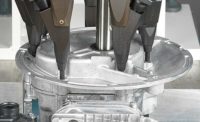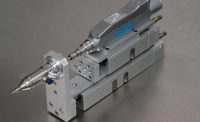Flexible parts feeding is a lot like education spending. Most folks want only the best schools and the best teachers for their children. But, when it comes time to pay the piper, the enthusiasm quickly evaporates.
Similarly, manufacturing engineers would like to feed part A today, part B tomorrow and part C next month. But, when they realize that such flexibility will decrease the feed rate and increase the cost and complexity of the system, suddenly flexibility doesn't seem like such a good idea.
Consider the FlexFeeder, which was introduced some 10 years ago by robotics supplier Adept Technology Inc. (Livermore, CA). Designed to work with a SCARA robot, the FlexFeeder consisted of a lift bucket, three conveyor belts and a vision system.
The lift bucket dropped parts onto the top belt, which, in turn, dropped them onto a faster-moving middle belt. After the middle belt advanced a group of parts under the camera, a series of quick forward and backward motions separated the parts. The vision system identified correctly oriented parts and guided the robot to pick them up. Misoriented parts fell to the return belt when a new group of parts was moved into the viewing area. The return belt transferred the parts to the opposite end of the feeder and dropped them into the waiting lift bucket, and the cycle repeated itself.
On paper, the device seemed to answer three of the manufacturing engineer's biggest needs: automate more processes, reduce changeover time, and spread the cost of capital equipment over multiple products. But, sales of the FlexFeeder never materialized, and Adept has largely abandoned the product.
Bud Ross, president of RPM Flex Feeders (King of Prussia, PA), thinks he knows why. The problem, he says, wasn't the feeder, it was expectations. "The expectations for vision-guided robots and flexible feeders were off the charts," he says. "Engineers wanted very high feed rates, and that's not the intention of flex feeding at all.
"If you have to put together a three-part assembly at a rate of 20 to 30 per minute, you're teetering on the edge if you think you can do that entirely with flexible feeders. With a flex feeder, you can get a maximum feed rate of 30 to 45 parts per minute, and that's under the most optimal conditions. Flex feeding is not a high-speed technology, and it never will be."
Vibratory Feeders and Flexibility
Vibratory bowls are usually tooled to feed a specific part, but there are ways to increase their flexibility.
If a group of parts has similar characteristics, bowl engineers can sometimes make adjustable tooling so the entire group can be fed with the same bowl, says Dan Krieger, president of Pinnacle Feeding Systems (Maple Grove, MN). For example, a bowl could be made to feed several different 5/8 bolts. One group of bolts might have hex heads; another might have socket heads. The bolts may even have different lengths.
"We're building a bowl right now to feed a family of hydraulic fittings," says Krieger. "The male end of each fitting is the same, but there are different configurations on the other end. We can make adjustable tooling to accommodate those differences. But, if there's a night-and-day difference between the parts, it's difficult."
The same rule holds true for retooling existing feeder bowls. "If the new part is similar to the old one, it may be possible to grind some things down and retool an old bowl," says Krieger. "If the weight bias characteristics of the part are different, it's generally better to start from scratch. However, you may still be able to reuse the drive, the hopper and the in-line portion of the feed system."
Krieger estimates that 90 percent of old feeder bowls become scrap metal. "Because everything is welded, it would take too much work to clean up an old bowl. You're better off starting with a new basic bowl," he says.
Another flexibility option for vibratory feeders is to change the bowl, but not the base. Or, the assembly system can have multiple bowls supply parts to the same takeaway point. Depending on the product, there could be one bowl for each part variation. When product A is being assembled, the bowls for product B are blocked or turned off.
Dave Schuh, vice president of sales and marketing at MGS Machine Corp. (Maple Grove, MN), says flexibility is easier to achieve with centrifugal feeders than vibratory feeders.
Like vibratory feeders, centrifugal feeders are shaped like a bowl. A rotating plastic disk at the bottom of the bowl forces parts against tooling that accepts correctly oriented parts and rejects misoriented ones. The feed rate varies with the size and shape of the part and the speed of the disk. To feed a new part, assemblers just need to change the outside tooling ring.
New Approaches
The lackluster sales of Adept's FlexFeeder haven't stopped machine builders from experimenting with novel methods of flexible feeding. Indeed, improvements in robotics and vision guidance technology have sparked a renewed interest in the technology.
Like Adept's FlexFeeder, most of the new flexible feeders do not try to orient parts. Instead, they merely separate the parts and allow them to seek a natural, stable state.
"‘Stable' means that if you drop a handful of parts on a flat surface, they should come to rest very quickly," explains Ross.
One example of the new crop of flexible feeders is the AnyFeed FX from Flexfactory AG (Dietikon, Switzerland). Similar to Adept's FlexFeeder, the AnyFeed has a hopper that dispenses a small amount of parts onto one end of a long, narrow tray with a polyamid surface. Moving in a pattern of horizontal and vertical oscillations, the tray scatters the parts and pushes them away from the hopper to the opposite end, where a vision-guided robot picks up any correctly oriented parts. When there are no more correctly oriented parts, the tray uses a hopping motion to flip the remaining parts like a chef sautéing vegetables.
The tray is 950 millimeters long and comes in widths of 120, 180 and 220 millimeters. The oscillations and the hopping motion can be programmed to feed different parts. The pick area can be backlit with infrared or visible light to assist the vision system in locating good parts.
The device can supply up to 60 parts per minute, and it can handle parts up to 60 millimeters wide. Parts can be made of metal, plastic, rubber or wood. The device works best with parts that have a 50 percent chance of being correctly oriented when distributed randomly on the tray. Wide, flat parts are ideal.
RPM's Bowl-Disk Flex Feeder was designed to feed small, stable parts. A standard vibratory feeder bowl presents a single-file stream of singulated parts onto a rotating disk, explains Ross. The disk stops periodically to allow the vision system to image the parts and tell the robot where to get them. Parts that aren't picked up are deposited back in the bowl.
The disk can be made of any material, in any color or texture. It can also be backlit to silhouette the parts for the vision system. Engineers can control the acceleration and deceleration of the disk to prevent parts from coasting after the disk stops moving.
The Belt-Disk Flex Feeder is a variation of the Bowl-Disk Feeder. Instead of a feeder bowl, a narrow conveyor belt deposits parts onto the disk. A second conveyor belt takes unpicked parts back to the supply hopper.
Another option for flexible feeding is the Dyna-Slide vibratory brush feeder from Lipe Automation Equipment (Liverpool, NY). This device consists of one or more vibrating tool plates covered with a brushlike material. Vibrating the plate at a defined pitch and amplitude causes the parts to move in a particular direction. Part speed depends on the weight and shape of the part, as well as the frequency and amplitude of the vibration.
Four plates can be arranged in a rectangular pattern to circulate parts. If parts need to be flipped, one plate can be raised slightly above another. Adjustable tooling can be used to force parts into a single file.
Because the brushes act like soft springs, parts made of fragile materials, such as powdered metal, ceramics and glass, are handled without damage. It's also quieter than standard metal feeder bowls.
"It's probably the least expensive of the flex feeders," says Ross.
Sidebar: Device Combines Bowl Controller, PLC
Vibratory feeding systems usually require individual controllers for the hopper, bowl and track. In addition, a programmable logic controller is needed to coordinate the operation of these devices and provide a way to program the system.
The vibratory controller from Seismologic (Oakville, ON, Canada) does away with the need to wire each vibratory controller separately into a PLC. It combines three AC variable voltage controllers and a PLC into one unit.
By centralizing the control system, the device simplifies installation, operation and troubleshooting of vibratory feeding systems. The unit gives machine builders an alternative to building a complete panel with standard PLC, power supply, fuses and vibratory controllers.
The controller is available with up to 12 inputs, eight outputs, eight analog inputs, and three vibratory output channels to control a small automated assembly line or part of a large line. A 3-amp, 24-VDC power supply runs all PNP or NPN inputs and outputs. In addition, the unit's front pushbuttons can be programmed to perform any function, such as "stop," "start" or "home position," which effectively adds five user inputs.
Parameters such as counters and timers within any custom program can be adjusted in the customer settings menu.
No software or communication cable is needed to program the device. All programming can be performed through the user interface. With the Model D, a personal digital assistant can be used to upload and download programs via the infrared port. The controller is programmed using statement logic programming with 15 subroutines for multiple applications. To prevent unauthorized use, settings are protected by two levels of passwords.
For more information, call Seismologic at 800-204-4153 or visit www.seismologic.com.


